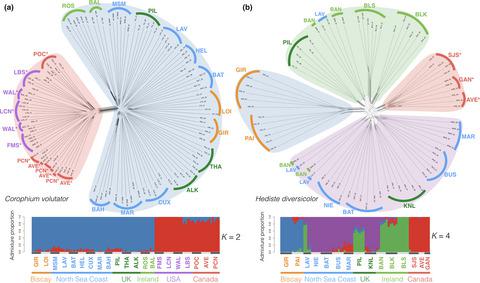当前位置:
X-MOL 学术
›
Ecol. Evol.
›
论文详情
Our official English website, www.x-mol.net, welcomes your
feedback! (Note: you will need to create a separate account there.)
Historical human activities reshape evolutionary trajectories across both native and introduced ranges.
Ecology and Evolution ( IF 2.3 ) Pub Date : 2020-05-24 , DOI: 10.1002/ece3.6391 Anthony L Einfeldt 1, 2 , Linley K Jesson 1, 3 , Jason A Addison 1
Ecology and Evolution ( IF 2.3 ) Pub Date : 2020-05-24 , DOI: 10.1002/ece3.6391 Anthony L Einfeldt 1, 2 , Linley K Jesson 1, 3 , Jason A Addison 1
Affiliation

|
The same vectors that introduce species to new ranges could move them among native populations, but how human‐mediated dispersal impacts native ranges has been difficult to address because human‐mediated dispersal and natural dispersal can simultaneously shape patterns of gene flow. Here, we disentangle human‐mediated dispersal from natural dispersal by exploiting a system where the primary vector was once extensive but has since ceased. From 10th to 19th Centuries, ships in the North Atlantic exchanged sediments dredged from the intertidal for ballast, which ended when seawater ballast tanks were adopted. We investigate genetic patterns from RADseq‐derived SNPs in the amphipod Corophium volutator (n = 121; 4,870 SNPs) and the annelid Hediste diversicolor (n = 78; 3,820 SNPs), which were introduced from Europe to North America, have limited natural dispersal capabilities, are abundant in intertidal sediments, but not commonly found in modern water ballast tanks. We detect similar levels of genetic subdivision among introduced North American populations and among native European populations. Phylogenetic networks and clustering analyses reveal population structure between sites, a high degree of phylogenetic reticulation within ranges, and phylogenetic splits between European and North American populations. These patterns are inconsistent with phylogeographic structure expected to arise from natural dispersal alone, suggesting human activity eroded ancestral phylogeographic structure between native populations, but was insufficient to overcome divergent processes between naturalized populations and their sources. Our results suggest human activity may alter species' evolutionary trajectories on a broad geographic scale via regional homogenization and global diversification, in some cases precluding historical inference from genetic data.
中文翻译:

历史上的人类活动重塑了本土和外来地区的进化轨迹。
将物种引入新范围的相同载体可以使它们在本地种群之间移动,但人类介导的扩散如何影响本地范围一直很难解决,因为人类介导的扩散和自然扩散可以同时塑造基因流的模式。在这里,我们通过利用一个系统,将人类介导的传播与自然传播分开,该系统的主要媒介曾经广泛,但后来已停止。从10世纪到19世纪,北大西洋的船舶用从潮间带挖出的沉积物交换压载水,直到采用海水压载舱才结束。我们研究了片足类Corophium v olutator ( n = 121; 4,870 SNP) 和环节动物Hediste diversicolor ( n = 78; 3,820 SNP) 中 RADseq 衍生的 SNP 的遗传模式,这些物种从欧洲引入北美,自然传播能力有限,在潮间带沉积物中含量丰富,但在现代压载水舱中并不常见。我们在引入的北美人群和欧洲本土人群中检测到相似水平的遗传细分。系统发育网络和聚类分析揭示了不同地点之间的种群结构、范围内的高度系统发育网状结构以及欧洲和北美种群之间的系统发育分裂。这些模式与预计仅由自然传播产生的系统发育地理结构不一致,表明人类活动侵蚀了本地种群之间的祖先系统发育地理结构,但不足以克服归化种群与其来源之间的分歧过程。 我们的研究结果表明,人类活动可能通过区域同质化和全球多样化在广泛的地理范围内改变物种的进化轨迹,在某些情况下排除了遗传数据的历史推论。
更新日期:2020-07-25
中文翻译:

历史上的人类活动重塑了本土和外来地区的进化轨迹。
将物种引入新范围的相同载体可以使它们在本地种群之间移动,但人类介导的扩散如何影响本地范围一直很难解决,因为人类介导的扩散和自然扩散可以同时塑造基因流的模式。在这里,我们通过利用一个系统,将人类介导的传播与自然传播分开,该系统的主要媒介曾经广泛,但后来已停止。从10世纪到19世纪,北大西洋的船舶用从潮间带挖出的沉积物交换压载水,直到采用海水压载舱才结束。我们研究了片足类Corophium v olutator ( n = 121; 4,870 SNP) 和环节动物Hediste diversicolor ( n = 78; 3,820 SNP) 中 RADseq 衍生的 SNP 的遗传模式,这些物种从欧洲引入北美,自然传播能力有限,在潮间带沉积物中含量丰富,但在现代压载水舱中并不常见。我们在引入的北美人群和欧洲本土人群中检测到相似水平的遗传细分。系统发育网络和聚类分析揭示了不同地点之间的种群结构、范围内的高度系统发育网状结构以及欧洲和北美种群之间的系统发育分裂。这些模式与预计仅由自然传播产生的系统发育地理结构不一致,表明人类活动侵蚀了本地种群之间的祖先系统发育地理结构,但不足以克服归化种群与其来源之间的分歧过程。 我们的研究结果表明,人类活动可能通过区域同质化和全球多样化在广泛的地理范围内改变物种的进化轨迹,在某些情况下排除了遗传数据的历史推论。











































 京公网安备 11010802027423号
京公网安备 11010802027423号